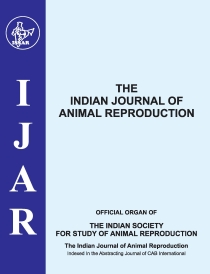Haemato-biochemical evaluation of chemotherapy in canine transmissible venereal tumour
DOI:
https://doi.org/10.48165/ijar.2023.44.01.5Keywords:
Chemotherapy, Haematology, Biochemistry, Transmissible venereal tumourAbstract
The study was aimed at haematological and biochemical evaluation of chemotherapeutic response in canine transmissible venereal tumour (CTVT). Thirty-one CTVT confirmed dogs presented to University Veterinary Hospitals were categorised into three groups. The group I (n=13) dogs were treated with vincristine sulphate, while group II (n=9) and III (n=9) dogs were treated with vincristine along with ivermectin and cyclophosphamide respectively. Haemato-biochemical evaluations were performed on the day of presentation and at weekly intervals till complete tumour regression. The haemato-biochemical parameters like TEC, Hb, VPRC, TP, BUN, creatinine, albumin, globulin and ALT were within normal range. Significant differenceswere observed in DLC, TC, MCV, AST, ALP and bilirubin levels (p<0.05) during treatment. Various blood dyscrasias like leucocytosis was observed in group I and group II, and thrombocytopenia in group III. Highly elevated AST, ALP and bilirubin were observed in all three groups. But combination therapy with ivermectin was more efficient with fewer adverse effects and decreased treatment duration.
References
Albanese, F., Salerni, F.L., Giordano, S. and Marconato, L. (2006). Extragenital transmissible venereal tumour associated with circulating neoplastic cells in an immunologically compro mised dog. Vet. Comp. Oncol., 4: 57-62.
Alkan, H., Satilmis, F., Alcigir, M.E., Kivrak, M.B. and Aydin, I. (2017). Clinicopathological evaluation of disseminated metastases of transmissible venereal tumour in a spayed bitch. Acta Sci. Vet., 45: 1-6.
Behera, S.K., Kurade, N.P., Monsang, S.W., Das, D.P., Mishra, K.K. and Mohanta, R.K. (2012). Clinico-pathological find ings in a case of canine cutaneous metastatic transmissible venereal tumour. Vet. Arh., 82: 401-410.
Birhan, G. and Chanie, M. (2015). A review on canine transmis sible venereal tumour: from morphologic to biochemical and molecular diagnosis. Acad. J. Anim. Dis., 4: 185-195.
Braz, P.H. and Marinho, C.P. (2021). Comparison between hematological and biochemical changes caused by conven
tional and metronomic chemotherapies in the treatment of canine transmissible venereal tumour. Braz. J. Vet. Res., 41: e06575.
Cunha, S.C., Silva, F.B.F., Corgozinho, K.B., da Silva, K.G.C. and Ferreira, A.M.R. (2017). Adverse effects of chemotherapy in dogs. Wld. Vet. J.,7: 74-82.
Jain, A., Tiwari, R.P., Tiwari, S.K., Gupta, N. and Awasthi, M.K. (2002). Clinical observations in TVT affected dogs treated with vincristine sulfate. Indian J. Anim. Reprod., 23: 71-72.
Kumar, V.A., Kumari, K.N., Kumar, K.S. and Gireesh, V. (2017). Hemato-biochemical changes in transmissible venereal tumours (TVT) affected dogs. Pharm. Innov. J., 6: 313-315.
Nazer, A.T., Becha, B.B., Jayakumar, C., Unnikrishnan, M.P. and Devi, S.S. (2023). Occurrence of canine transmissible vene real tumour. J. Vet. Anim. Sci., 54(2): 382-387.
Priyadarshini, N., Das, D.P., Panda, S.K. and Samal, L. (2021). Transmissible venereal tumours (TVT) in bitches: A hae matological, biochemical and histopathological study. J. Entomol. Zool. Stud., 9: 490-493.
Snedecor, G.W. and Cochran, W.G. (1994). Statistical Methods. (8th Ed.) Iowa State University Press, U.S.A., 564p. Strakova, A. and Murchison, E.P. (2014). The changing global distribution and prevalence of canine transmissible vene real tumour. BMC Vet. Res., 10: 1-11.
Yadav, A., Bugalia, N.S. and Pandey, A.K. (2018). Haemato biochemical and therapeutic evaluation of doxorubicin and vincristine in canine transmissible venereal tumour. Indian J. Anim. Reprod., 39: 40-42.




